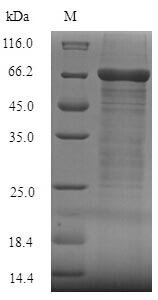Recombinant Human Fc receptor-like protein 4 (FCRL4) is expressed in an E. coli system, covering the extracellular domain from amino acids 20 to 387. The protein includes an N-terminal 6xHis-SUMO tag that aids in purification and detection. Purity levels exceed 90% as verified by SDS-PAGE, which appears to ensure reliable performance in research applications. This product is intended for research use only and is not suitable for diagnostic or therapeutic purposes.
FCRL4 belongs to the Fc receptor-like family, which seems to play a role in modulating immune responses. Certain B cell subsets primarily express this protein, and it's involved in regulating immune signaling pathways. Research focused on understanding immune regulation and the development of immune-related conditions may find this protein significant, as it provides valuable insights into immune system dynamics.
Potential Applications
Note: The applications listed below are based on what we know about this protein's biological functions, published research, and experience from experts in the field. However, we haven't fully tested all of these applications ourselves yet. We'd recommend running some preliminary tests first to make sure they work for your specific research goals.
Based on the provided information, the folding state and bioactivity of this recombinant FCRL4 protein are unknown and must be considered highly uncertain. FCRL4 is an immunoglobulin (Ig) domain-containing receptor, and its extracellular domain's function is critically dependent on correct disulfide bond formation and proper folding of its Ig-like domains to present the correct surfaces for ligand binding. Expression in the reducing cytoplasm of E. coli makes correct disulfide bond formation unlikely. Furthermore, the presence of a large N-terminal 6xHis-SUMO tag may sterically hinder the N-terminal region of the extracellular domain, which is critical for its structure. Therefore, it is highly improbable that this protein is correctly folded and bioactive for its specific receptor functions. Applications relying on specific biological interactions are speculative without validation.
1. Antibody Development and Characterization
This recombinant FCRL4 extracellular domain is suitable for use as an immunogen to generate antibodies. The high purity is adequate for immunization. Antibodies generated will be primarily against the linear epitopes of this non-glycosylated, likely misfolded protein. Their ability to recognize the natively folded, glycosylated FCRL4 on the surface of human B cells is very low and requires rigorous validation. The protein is most reliable for generating antibodies that work in denaturing techniques like Western blot.
2. ELISA-Based Binding Assays
The His-SUMO tagged protein can be immobilized in an ELISA. However, its utility is severely limited. It is suitable for screening antibodies raised against itself. It is not suitable for screening potential ligands or for quantitative analysis of binding affinities because the binding site is almost certainly not functional. Any binding detected would be an artifact and not representative of the native FCRL4-ligand interaction.
3. Biochemical Characterization and Stability Studies
This purified recombinant protein is well-suited for basic biochemical and biophysical characterization. Techniques like circular dichroism, size exclusion chromatography, and dynamic light scattering can be used to analyze its secondary structure, oligomeric state, and aggregation propensity. This application is valid as it focuses on the intrinsic physical properties of the purified polypeptide, independent of its native bioactivity.
Final Recommendation & Action Plan
The recommended course of action is to restrict the use of this protein lot to applications that do not depend on native conformation. It can be reliably used for antibody production (Application 1, with the clear goal of generating tools for detecting linear epitopes) and for biophysical characterization of the recombinant material itself (Application 3). Assays that aim to study specific protein-protein interactions or ligand binding are not feasible with this protein and should be abandoned, as they will generate biologically irrelevant data. For functional studies, an active FCRL4 extracellular domain would need to be produced in a mammalian expression system to ensure proper glycosylation, disulfide bond formation, and folding.






